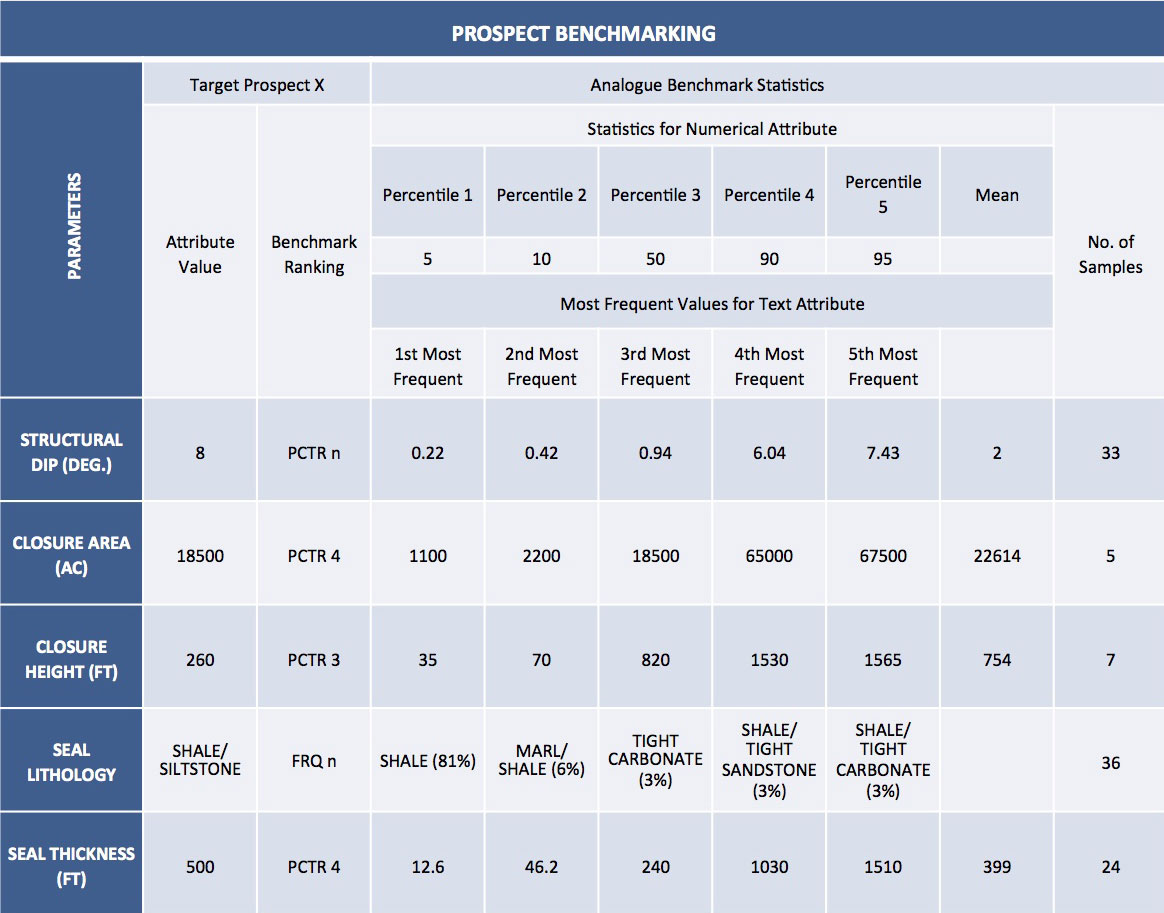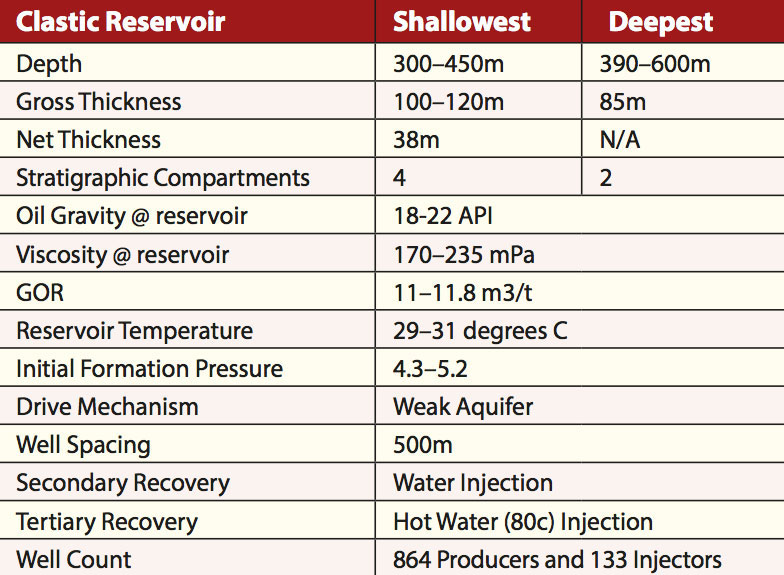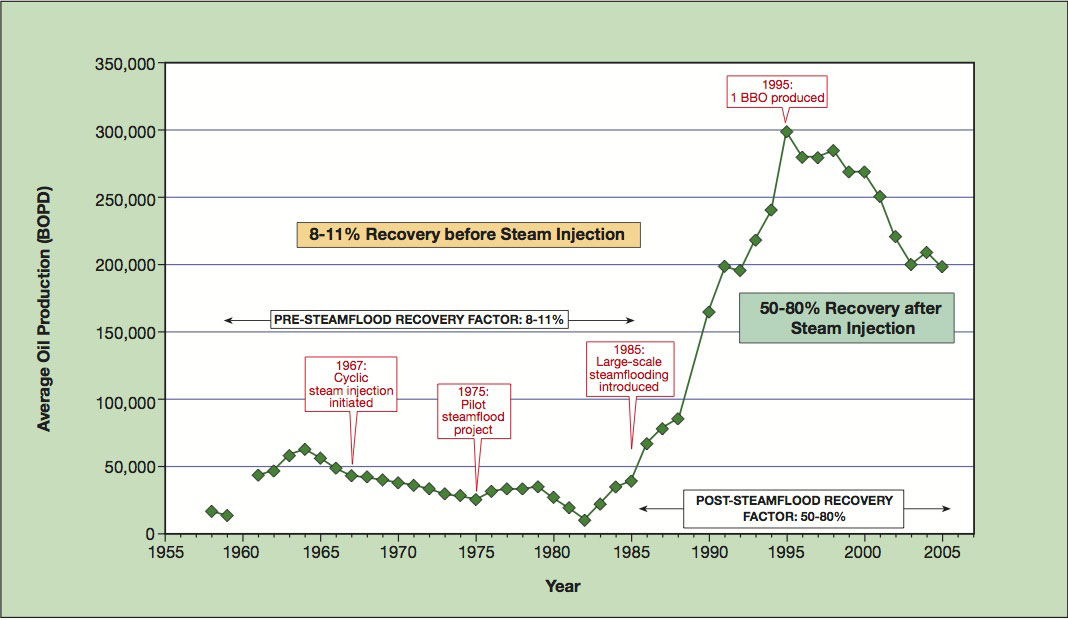technical evaluation team must analyse all available data types – seismic, well logs, test and production data, cores and analogues – in making technical and business decisions in exploration and production. Often a lack of resources or time constraints mean this requirement is not fully undertaken; then the required due diligence suffers and consequently dry holes are drilled, field developments disappoint and acquired reserves are moved to the goodwill section of the acquisition. The question may still remain unanswered as to whether the opportunity was ever properly evaluated. A systematic way to reduce such unwelcome technical surprises and to better understand the opportunity is to use analogue fields and reservoirs for reference and benchmarking purposes.
Using Analogues
Existing oil and gas fields provide analogues, allowing for a direct comparison between an investment opportunity and the positive results (i.e. producing fields) which have been achieved from analogous exploration plays. Sadly the use of analogues is often haphazardly applied and with little rigour. A single analogue is often referenced because it looks similar on seismic data or with luck it is in the same basin and geographic region. How many times in recent history has the Jubilee field been used as an analogue for the numerous exploration opportunities up and down the West African and South American coasts – yet how many actually truly compare with Jubilee’s setting?
The use of a single analogue carries inherent risk and is insufficient to benchmark or characterise an opportunity. Such ad hoc methods usually result in inappropriate analogues being applied for comparative purposes.
The basic critical element of any analogue database is consistency for all the technical parameters. Examples of such parameters which require absolute consistency are basin type, tectonic regime, structural setting, trapping mechanism, depositional system and environment of the reservoir, the reservoir lithology, reservoir properties and thickness, seal lithology and configuration. However, these are just the minimum technical parameters required. The development of an internal multi-analogue database with adequate technical parameters requires a significant amount of work and places itself beyond the capabilities of most E&P companies.
A major weakness to date has been the inability to directly characterise the opportunity being evaluated (new play, prospect or field development) against commercially available analogue databases.
New Platform
Addressing this deficiency, C&C Reservoirs has developed a new platform, DAKS – Digital Analog Knowledge System – which enables the comprehensive characterisation and benchmarking of over 200 technical parameters collated in its 1,400+ analogue field database (FAKS) against users’ own data which is documented in the UFK (User Field Knowledge) module.
The UFK proprietary platform enables geoscientists and engineers to directly enter and store technical static and dynamic data of their subject of investigation. This allows for direct comparison and plotting of the opportunity’s technical parameters against identical technical parameters from the analogue fields contained within the standardised global field and reservoir analogue dataset in FAKS. Users can further modify and customise the data model in the UFK to their own specifications by building their own unique data model (Client Defined Data Models or CDDM). The new web-based UFK tool undertakes a statistical analysis of all the critical technical data associated with an opportunity and its analogues and generates these as P10-P50-P90 percentile distributions.
In peer assist and peer reviews, discussions currently tend to revolve around the experiences of the personnel involved and/or the one identified analogue, and often the critical risk elements are not fully understood or recognised due to lack of true benchmarking in these processes. The introduction of technology whereby an E&P opportunity can be directly compared with numerous global analogues allows for better and more focused analysis of the potential risks.
Using Global Analogues
A few examples of the advantages of applying such technology are discussed below.
Play characterisation: In this example, a recent licensing round offered a large number of exploration blocks which had very sparse amounts of well and seismic data, but were aligned with a large regional producing trend. By using search parameters based on the tectonic structural setting of the blocks, FAKS enabled a characterisation of the play based on 60 producing, similarly-aged reservoirs, with a similar tectonic setting from within the region, i.e. true analogue data. Users have the option of selecting from a combination of up to 236 technical parameters for a tabulated full play characterisation, which allows screening economics to be run early in the evaluation cycle to determine MEFS (minimum economic field size). It can also highlight any potential production problems such as high viscosity oil, or high inert gas content, factors which can add to the complexity of any potential future field development and can risk increasing project costs.
 Prospect benchmarking: The UFK and FAKS tools allow for numerous field analogues to be used for benchmarking a prospect on a P10-P50-P90 distribution basis, automatically highlighting those prospect parameters which lie outside of the P10 and P90 values of the analogues. ‘Prospect X’, a Mesozoic lateral depositional pinch-out trap, was evaluated using FAKS and UFK. The full benchmarking process covered over 80 technical parameters and these were compared to the 36 closest analogue fields identified in the system. The exercise flagged that two technical parameters for the prospect, namely structural dip of the trap and the prognosed seal lithology, lay outside the normal P10-P50-P90 percentile distribution for the 36 analogues, as shown by the graphs below.
Prospect benchmarking: The UFK and FAKS tools allow for numerous field analogues to be used for benchmarking a prospect on a P10-P50-P90 distribution basis, automatically highlighting those prospect parameters which lie outside of the P10 and P90 values of the analogues. ‘Prospect X’, a Mesozoic lateral depositional pinch-out trap, was evaluated using FAKS and UFK. The full benchmarking process covered over 80 technical parameters and these were compared to the 36 closest analogue fields identified in the system. The exercise flagged that two technical parameters for the prospect, namely structural dip of the trap and the prognosed seal lithology, lay outside the normal P10-P50-P90 percentile distribution for the 36 analogues, as shown by the graphs below.
This analysis should now guide the interpretation team to focus on resolving the seal issue and address the question of whether the prognosed hydrocarbon column is likely to breach the shale/siltstone seal – ultimately determining if this risk is sufficient to deter drilling. This example demonstrates the benefits of this new technology for prospect benchmarking against global analogues and highlights how technical issues that might have otherwise been easily missed are now identified.
Post-mortem analysis: The input of the pre-drill and the post-drill parameters into the module allow for a direct comparison against each other and against the global analogues (i.e. successful commercial accumulations).
Field development planning: Many performance uncertainties exist particularly in the early stages of a development. The UFK and FAKS modules allow for comparison between the proprietary field and analogue fields to provide quantitative envelopes to help in development planning and production optimisation.
Improved hydrocarbon recovery: Reservoir engineers can find all fields that share a similar set of geological and engineering parameters and which have gone through secondary and tertiary recovery production stages. The performance of production enhancement cases can be readily retrieved and reviewed. The engineer can then compare his field’s performance versus these analogues fields and determine the most effective production enhancement methods and estimated performance for their candidate fields.
 Key Field ParametersMature and abandoned fields: When evaluating these types of opportunities available from host governments, reservoir engineers can enter all the available data into the UFK module and then determine whether specific technologies, such as horizontal and multilateral drilling, under-balanced drilling or gravity-assisted thermal recovery, used in analogue fields, might allow such technological solutions to create profitable investment opportunities.
Key Field ParametersMature and abandoned fields: When evaluating these types of opportunities available from host governments, reservoir engineers can enter all the available data into the UFK module and then determine whether specific technologies, such as horizontal and multilateral drilling, under-balanced drilling or gravity-assisted thermal recovery, used in analogue fields, might allow such technological solutions to create profitable investment opportunities.
A recent peer review of a field redevelopment opportunity in Central Asia concluded that the shallow reservoir depth combined with the low temperature and the large number of structural compartments were the most critical factors. However, when the opportunity was benchmarked against the analogues, it was found that the two most anomalous parameters were oil gravity and viscosity.
 Analogue field production: 18–22° API, 180 mPa at reservoir.Further analogue analysis indicated that high recovery factors could be obtained from high viscosity reservoirs and that cyclical steam injection combined with closer well spacing had the highest probability of achieving the goal of higher recovery factors, as shown in the graphs and table on the right. Subsequently, the team revised its original proposed re-development plan, with a view to decreasing the well spacing to less than 500m in combination with steam injection and horizontal producing wells. The new re-development plan indicated that a multi-million dollar potential value had been added to the opportunity.
Analogue field production: 18–22° API, 180 mPa at reservoir.Further analogue analysis indicated that high recovery factors could be obtained from high viscosity reservoirs and that cyclical steam injection combined with closer well spacing had the highest probability of achieving the goal of higher recovery factors, as shown in the graphs and table on the right. Subsequently, the team revised its original proposed re-development plan, with a view to decreasing the well spacing to less than 500m in combination with steam injection and horizontal producing wells. The new re-development plan indicated that a multi-million dollar potential value had been added to the opportunity.
Portfolio Analysis: Several E&P companies, including a number of NOCs, are now able to enter all the static and dynamic data on their producing fields into the UFK module, allowing engineers to make a direct comparison between each field and to determine why some fields are comparatively under-performing. This allows determination of candidates for divestiture and candidates for additional investment.
Preparing for Surprises
In the complex subsurface world of exploration and production, there will always be surprises, welcome and unwelcome. DAKS technology gives geological and engineering professionals the opportunity to reduce the risk of such surprises by expanding their experience base to include the benchmarking of over 1400 commercial oil and gas fields across the globe.









